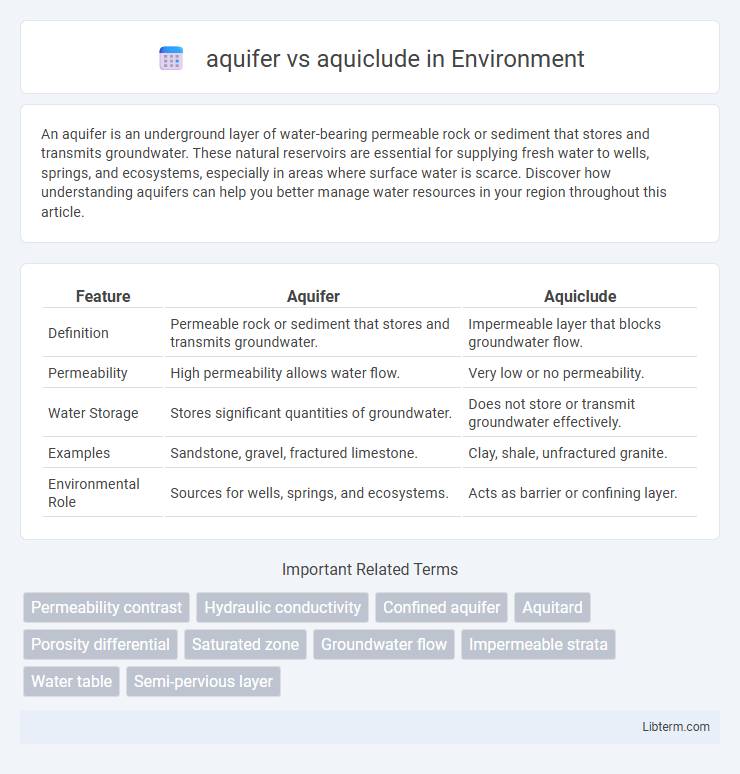An aquifer is an underground layer of water-bearing permeable rock or sediment that stores and transmits groundwater. These natural reservoirs are essential for supplying fresh water to wells, springs, and ecosystems, especially in areas where surface water is scarce. Discover how understanding aquifers can help you better manage water resources in your region throughout this article.
Table of Comparison
| Feature | Aquifer | Aquiclude |
|---|---|---|
| Definition | Permeable rock or sediment that stores and transmits groundwater. | Impermeable layer that blocks groundwater flow. |
| Permeability | High permeability allows water flow. | Very low or no permeability. |
| Water Storage | Stores significant quantities of groundwater. | Does not store or transmit groundwater effectively. |
| Examples | Sandstone, gravel, fractured limestone. | Clay, shale, unfractured granite. |
| Environmental Role | Sources for wells, springs, and ecosystems. | Acts as barrier or confining layer. |
Introduction to Aquifers and Aquicludes
Aquifers are underground layers of permeable rock or sediment that store and transmit groundwater, making them essential sources for wells and springs. Aquicludes consist of impermeable materials such as clay or dense rock that block water flow, acting as barriers to groundwater movement. Understanding the distinction between aquifers and aquicludes is critical for effective groundwater management and hydrogeological studies.
Definition of Aquifer
An aquifer is a porous, permeable underground layer of rock or sediment that stores and transmits groundwater, allowing water to flow through its interconnected spaces. It contrasts with an aquiclude, which is a geological formation composed of impermeable materials that restrict or prevent the movement of groundwater. The primary function of an aquifer is to act as a natural reservoir, supplying water to wells, springs, and ecosystems.
Definition of Aquiclude
An aquiclude is a geological formation that acts as a barrier to groundwater flow due to its extremely low permeability or porosity, effectively preventing water movement. Unlike an aquifer, which stores and transmits groundwater, an aquiclude restricts water from passing through it, creating a confined space for aquifers above or below it. Common materials forming aquicludes include clay and dense shale, which impede water flow and influence groundwater distribution.
Key Differences Between Aquifers and Aquicludes
Aquifers are permeable geological formations that store and transmit groundwater, essential for wells and springs, whereas aquicludes are impermeable layers that restrict water flow and prevent groundwater movement. The primary difference lies in permeability: aquifers allow water extraction and flow due to high porosity and permeability, while aquicludes act as barriers with low permeability, often composed of clay or dense rock. Understanding this distinction is crucial for hydrogeology, groundwater management, and environmental engineering.
Types of Aquifers
Types of aquifers include unconfined, confined, and perched aquifers, each differing in permeability and water retention. Unconfined aquifers allow water to flow freely due to porous materials, while confined aquifers are trapped between impermeable layers acting as aquicludes, restricting water movement. Aquicludes consist of impermeable substrates such as clay or shale that prevent water flow, effectively creating barriers within groundwater systems.
Types of Aquicludes
Aquicludes are geological formations that restrict groundwater flow due to their low permeability, contrasting with aquifers which store and transmit water. Types of aquicludes include shales, claystones, and dense crystalline rocks, each varying in their ability to impede water movement. Understanding the specific lithological characteristics of these aquicludes is crucial for groundwater management and hydrogeological modeling.
Importance in Groundwater Management
Aquifers are crucial for groundwater management as they store and transmit significant quantities of water, supporting wells and natural ecosystems. Aquicludes act as impermeable barriers that limit the flow of groundwater, helping to compartmentalize aquifers and maintain water quality by preventing contamination spread. Understanding the distribution and properties of both aquifers and aquicludes enables efficient groundwater extraction and protection strategies.
Geological Examples of Aquifers
The Ogallala Aquifer in the central United States is a prominent example of a vast and productive aquifer, composed primarily of unconsolidated sand, gravel, and silt that efficiently stores and transmits groundwater. The Nubian Sandstone Aquifer System, spanning parts of northeastern Africa, is another key example, characterized by its thick sandstone layers that act as extensive reservoirs of freshwater beneath arid regions. These geological formations contrast with aquicludes like shale and claystone, which possess low permeability and hinder groundwater flow, serving as natural barriers within hydrogeological systems.
Geological Examples of Aquicludes
Aquicludes are geological formations that restrict groundwater flow due to their low permeability, such as shale and claystone layers, commonly found in sedimentary basins like the Gulf Coast of the United States. These formations contrast with aquifers, which consist of permeable materials like sandstone or fractured limestone capable of storing and transmitting groundwater. Understanding the distribution of aquicludes is crucial for hydrogeological studies and groundwater management in regions characterized by alternating permeable and impermeable strata.
Aquifer and Aquiclude in Environmental Sustainability
Aquifers, permeable geological formations that store and transmit groundwater, are vital for maintaining sustainable water supplies and supporting ecosystems in environmental sustainability. Aquicludes, by contrast, are impermeable layers that restrict groundwater flow, protecting aquifers from contamination but limiting recharge rates. Effective management of aquifers and understanding aquiclude boundaries are essential to balance groundwater extraction with natural replenishment, ensuring long-term water resource sustainability.
aquifer Infographic

 libterm.com
libterm.com